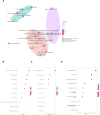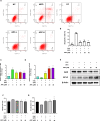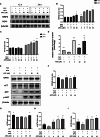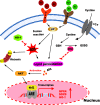Arctiin alleviates knee osteoarthritis by suppressing chondrocyte oxidative stress induced by accumulated iron via AKT/NRF2/HO-1 signaling pathway
- PMID: 39738432
- PMCID: PMC11685860
- DOI: 10.1038/s41598-024-83383-7
Arctiin alleviates knee osteoarthritis by suppressing chondrocyte oxidative stress induced by accumulated iron via AKT/NRF2/HO-1 signaling pathway
Abstract
Iron overload (IO) was considered to be a risk factor for cartilage degradation in knee osteoarthritis (KOA) advancement. However, few drugs were found to improve cartilage degeneration by alleviating multiple cell death induced by the impaired iron level of the knee joints. We aimed to elucidate that Arctiin (ARC) plays a role in managing KOA caused by accumulated iron levels by restoring chondrocyte apoptosis and ferroptosis. Single-cell RNA sequencing analysis was used to discover the disparities in chondrocytes between KOA patients and non-KOA individuals. CCK-8 assay was performed to detect chondrocyte viability. Annexin V-FITC/PI staining determined the cell apoptosis rate. The fluorescence density reflected the iron content, ROS, lipid-ROS, and mitochondrial membrane potential. Q-RTPCR and Western Blotting were used to detect the expression levels of genes and proteins expression. Micro-CT and Safranin O-Fast Green staining were used to detect the phenotype of the knee joints. ARC increased cell viability and inhibited chondrocyte apoptosis. Further, ARC acts as an anti-ferroptosis effect by reducing the intracellular iron, ROS, and lipid-ROS content and restoring mitochondrial damage. Based on the results of scRNA-seq, we found that ARC can play a role by activating AKT/NRF2/HO-1 signaling pathway. In vivo, ARC can significantly improve the severity of KOA caused by IO. ARC alleviates oxidative stress in chondrocytes via the AKT/NRF2/HO-1 signaling pathway, suggesting the potential application of ARC in KOA.
Keywords: Apoptosis; Cartilage degeneration; Ferroptosis; Herbal medicine; Iron overload.
© 2024. The Author(s).
Conflict of interest statement
Declarations. Consent for publication: Written informed consent for publication was obtained from all participants. Competing interests: The authors declare no competing interests. Institutional Review Board Statement: All animal experiments were approved by the Review Board of The First Affiliated Hospital of Guangzhou University of Chinese Medicine (Ethic NO. TCMF1-2021029).
Figures









Similar articles
-
Biochanin A protects against iron overload associated knee osteoarthritis via regulating iron levels and NRF2/System xc-/GPX4 axis.Biomed Pharmacother. 2023 Jan;157:113915. doi: 10.1016/j.biopha.2022.113915. Epub 2022 Nov 12. Biomed Pharmacother. 2023. PMID: 36379122
-
[Mechanism of acupotomy on chondrocyte ferroptosis in rabbits with knee osteoarthritis based on HSPA5/GPX4 signaling pathway].Zhongguo Zhen Jiu. 2024 May 12;44(5):555-64. doi: 10.13703/j.0255-2930.20230901-k0001. Zhongguo Zhen Jiu. 2024. PMID: 38764106 Chinese.
-
NOX1-mediated oxidative stress induces chondrocyte ferroptosis by inhibiting the Nrf2/HO-1 pathway.Sci Rep. 2024 Aug 27;14(1):19877. doi: 10.1038/s41598-024-70991-6. Sci Rep. 2024. PMID: 39191890 Free PMC article.
-
Novel insights into the role of ferroptosis in temporomandibular joint osteoarthritis and knee osteoarthritis.Int J Med Sci. 2025 Apr 9;22(9):2119-2131. doi: 10.7150/ijms.107057. eCollection 2025. Int J Med Sci. 2025. PMID: 40303500 Free PMC article. Review.
-
Impact of Abnormal Mechanical Stress on Chondrocyte Death in Osteoarthritis.Med Sci Monit. 2025 Jun 10;31:e948290. doi: 10.12659/MSM.948290. Med Sci Monit. 2025. PMID: 40493524 Free PMC article. Review.
References
-
- Hunter, D. J., Bierma-Zeinstra, S. & Osteoarthritis Lancet393, 1745–1759, doi:10.1016/s0140-6736(19)30417-9 (2019). - PubMed
Publication types
MeSH terms
Substances
Grants and funding
LinkOut - more resources
Full Text Sources
Medical
Research Materials
Miscellaneous

